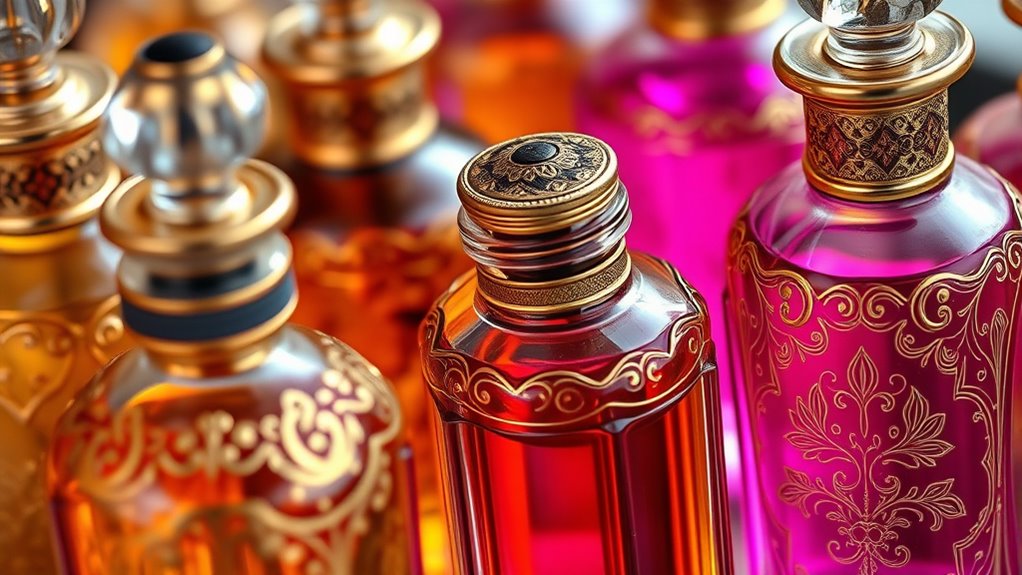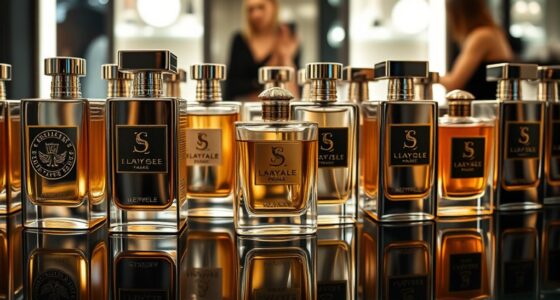Attars and perfume oils are a timeless craft that combines natural ingredients with traditional techniques passed down through generations. They’re valued for their rich, authentic scents that last for hours or even days. Crafting these fragrances involves blending rare plant extracts, spices, and resins with care and patience, often taking weeks or months. To discover more about this art’s cultural depth and craftsmanship, keep exploring what makes these scents truly special.
Key Takeaways
- Attars and perfume oils are centuries-old crafts emphasizing natural ingredients and traditional blending techniques.
- They are known for their long-lasting scent due to concentrated natural extracts and careful preservation methods.
- The creation process involves slow maceration and distillation, reflecting artisanal skill passed through generations.
- Natural ingredients like sandalwood oil serve as carriers and preservatives, ensuring purity and authentic fragrance.
- These fragrances embody cultural heritage, emphasizing craftsmanship, patience, and a deep connection to nature.

Attars and perfume oils have been cherished for centuries as rich, natural scents that embody tradition and craftsmanship. When you wear an attar, you’re not just smelling a fragrance; you’re experiencing a centuries-old art form that emphasizes purity and skill. One of the most remarkable qualities of these oils is their scent longevity. Unlike many modern perfumes that fade quickly, attars tend to linger on your skin for hours, sometimes even days, thanks to their concentrated nature and natural ingredients. This extended wear is no accident but the result of meticulous process—highlighting the importance of traditional blending techniques. These methods, passed down through generations, involve carefully selecting and combining raw materials to create harmonious, balanced fragrances that stand the test of time. Additionally, the natural ingredients used in attars contribute to their purity and authenticity, setting them apart from synthetic alternatives. Traditional blending techniques are at the heart of what makes attars unique. You’ll find that master artisans pay close attention to the ratios and harmony of each ingredient. Unlike synthetic perfumes, which often rely on chemical shortcuts, attars are crafted through a slow, deliberate process. They typically involve macerating plant extracts, flowers, spices, and resins in a base of sandalwood oil, which acts as both a carrier and a preservative. The blending process can take weeks or even months, during which the aroma evolves and deepens. This patience and precision ensure that each attar has a complex, multi-layered scent profile that reveals itself over time. The traditional techniques also involve distillation and infusion, methods that help preserve the natural integrity of each ingredient, resulting in a pure, authentic fragrance. When you choose an attar, you’re embracing a tradition that values authenticity over mass production. Every drop reflects the skill and artistry of the perfumer, who considers not just the scent but also its evolution and harmony. The use of natural ingredients and time-honored blending methods ensures that the fragrance remains true to its roots and offers a sensory experience that synthetic perfumes often cannot match. The enduring scent and rich complexity of attars are proof of their craftsmanship. So, whether you’re seeking a signature scent or a meaningful gift, understanding the importance of scent longevity and traditional blending techniques can deepen your appreciation for these timeless treasures. They’re more than just fragrances—they’re living art, crafted with patience, passion, and respect for nature’s bounty.
Frequently Asked Questions
What Are the Origins of Traditional Attars?
You might find that traditional attars originate from ancient Persia and India, where they hold deep historical significance. These fragrant oils symbolize cultural identity and spiritual beliefs, often used in religious rituals and ceremonies. Over centuries, their craftsmanship spread along trade routes, enriching their cultural symbolism. You harness the aromatic essence of history, tradition, and artistry, making attars a meaningful part of cultural heritage and personal expression today.
How Are Perfume Oils Made Without Alcohol?
You can make perfume oils without alcohol by using extracting methods like steam distillation or cold pressing, which preserve the pure essence of ingredients. After extraction, the oils are often aged for months or years, allowing the scents to deepen and harmonize. This aging process enhances the fragrance’s richness, creating a luxurious, alcohol-free perfume oil that’s pure, natural, and long-lasting.
Which Herbs and Flowers Are Commonly Used?
You typically use herbs like sandalwood, vetiver, and rose, along with flowers such as jasmine and mogra, to create aromatic blends. These herbs and flowers are chosen for their medicinal properties and fragrant qualities, which enhance the scent and therapeutic benefits of the perfume oils. By distilling or macerating these ingredients, you craft rich, natural aromas that preserve traditional methods and offer a unique sensory experience.
How Long Do Traditional Attars Typically Last?
You’ll find traditional attars last quite long, often between 12 to 24 hours, thanks to their natural ingredients and concentrated oils. To guarantee maximum scent longevity, store them in cool, dark places away from sunlight and air exposure. Keep the bottles tightly sealed to preserve their aroma and potency. Proper storage tips help maintain the rich fragrance, allowing you to enjoy the traditional art of attars for extended periods.
Are There Specific Cultural Rituals Associated With Attars?
Ever wonder if attars have special cultural rituals? They certainly do, playing a essential role in cultural significance and ritual application across many traditions. You might find them used during religious ceremonies, weddings, or important celebrations, symbolizing purity, protection, or blessings. These fragrant oils are more than just scents; they’re deeply embedded in cultural identity, making their ritual use a meaningful part of social and spiritual practices worldwide.
Conclusion
You now see how attars and perfume oils embody centuries of tradition and craftsmanship. Did you know that the global perfume market is expected to reach $75 billion by 2025? By appreciating these aromatic treasures, you connect with a rich cultural heritage that’s still thriving today. Embrace the art, and let these enchanting scents transform your experience, reminding you that some traditions, like perfume-making, are truly timeless.









